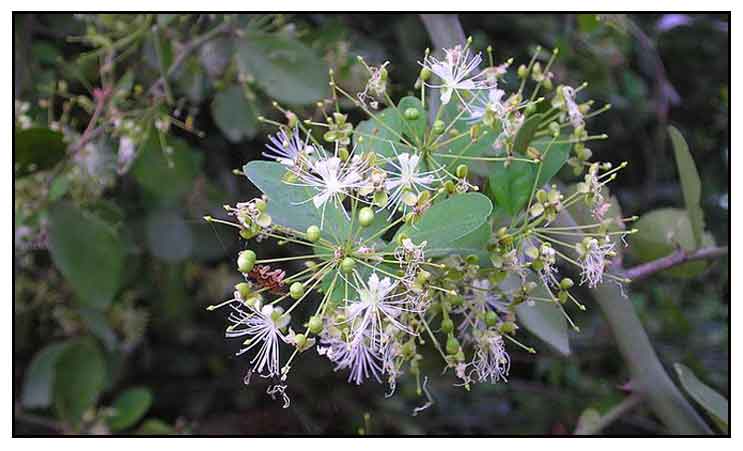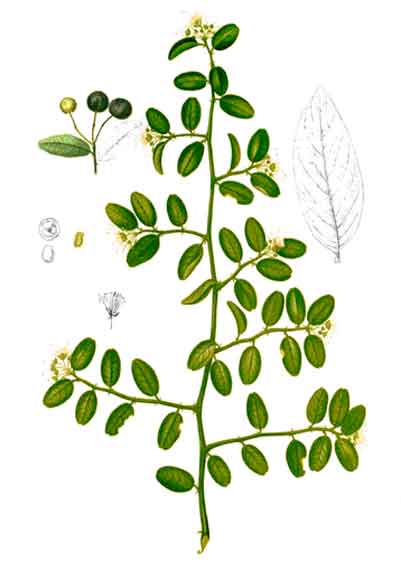
Botany
Tarabtab is a woody vine, growing from 1.5 to 3 meters in height. Young branches are hairy. Spines are short, sharp, and recurved. Leaves are oblong-ovate to elliptic-ovate, 2 to 8 centimeters long, with a shallow notch at the tip. Flowers are grouped 5 to 15 in axillary and terminal, sessile or short-peduncled umbels, with the slender pedicels 1 to 1.5 centimeters long. Sepals are green and concave. Petals are oblong, white, and 7 to 8 millimeters long. Fruit is rounded, 8 t 10 millimeters in diameter, nearly black when mature, and one-seeded.
 Distribution Distribution
- In thickets at low altitudes from the Babuyan Islands and northern Luzon to Mindanao and the Sulu Archipelago.
- Occurs in India to Malaya and Australia.
- Widely distributed in India, Pakistan, Myanmar and Sri Lanka.
Constituents
- Phytochemical screening of ethanol extract of leaves yielded reducing sugars, flavonoids, steroids, tannins, glycosides, alkaloids, gums, resins, amino acids, proteins and anthraquinones. (see study below) (2)
- Studies yielded alkaloids, glycosides, carbohydrates, anthocyanins, flavonoids, sterols, terpenes and amino acids.
-
Leaf contains four pentacyclic triterpenoid ethanol, taraxasterol, α and β-amyrin, β- sitosterol, erythrodiol
Properties
- Febrifugal, alterative, tonic.
- Considered blood purifier stomachic, tonic, and appetizer.
- Roots considered anti-inflammatory and analgesic.
- Studies have suggested antidiabetic, hepatoprotective, cardioprotective, antibacterial, analgesic, anti-inflammatory, antitumor, antioxidant properties.
Parts used
Bark, stem, roots, leaves.
Uses
Folkloric
- Used as febrifuge, alterative, and tonic.
- Used for skin diseases.
- In India, traditionally used as blood purifier stomachic, tonic, and appetizer. Fresh bark, stem, and leaves used to treat eczema, dandruff and to reduce body heat. Flowers leaves, and roots used in cough and toxemia. Root powder used for inflammation and diseases of the muscles; also used for snake bites.
- Roots used in earaches and mumps; stem bark and root bark used for treating dropsy, gout, and aphthae. (12)
- In Ayurveda, known as 'Himsra' and described as 'Hrudayottejak'- cardiotonic. (13)
Studies
• Toxicity Studies / Phytochemicals: - Phytochemical screening of ethanol extract of leaves yielded reducing sugars, flavonoids, steroids, tannins, glycosides, alkaloids, gums, resins, amino acids, proteins and anthraquinones. Rich in various biologically active compounds, it is a potential source of crude drugs. Acute, subchronic,and chronic toxicity studies showed LD50s of300-5000 mg/kbw for 4-6 weeks.
• Anti-Diabetic / Leaves: Study evaluated an ethanol extract of C. sepiaria leaves for possible hypoglycemic effect in streptozotocin-induced diabetic rats. Results showed hypoglycemic effect and suggest a potential as adjunct to traditional formulation and treatment of diabetes mellitus. Acute toxicity study showed an LD50 894.43 mg/kbw. at various dose levels. (3)
• Hepatoprotective / Leaves / CCL4 / Antioxidant: Study of ethanolic extract of leaves of C. sepiaria in CCl4-induced hepatotoxicity in Wistar rats showed significant hepatoprotective effects, confirmed by histopathological studies of the liver. The extract also showed significant free radical scavenging activity in vitro. (4)
• Anti-Inflammatory / Analgesic: Study of petroleum ether, methanol, and water extracts of roots of Cs all showed significant anti-inflammatory and analgesic activities. (5)
• Hepatoprotective / Acetaminophen-Induced Hepatotoxicity / Roots: Study showed hepatoprotective activity of root extracts on acetaminophen-induced hepatotoxicity in albino Wistar rats. (7)
• Antitumor / Antioxidant / Bark: Study evaluated a methanol extract of bark for antitumor activity and antioxidant activity against Dalton's ascites lymphoma (DAL)-bearing Swiss albino mice. Results showed significant decrease in tumor volume, packed cell volume, and viable cell count, and prolonged the life span of DAL-tumor bearing mice. Lipid peroxidation and antioxidant levels increased significantly. (8)
• Antibacterial / Enteric Pathogens: Study evaluated the antibacterial properties of various extracts against different bacteria including E. coli, P mirabilis, S. typhi, Enterobacter aerogenes, and Shigella flexneri. A hexane extract showed maximum inhibition against Salmonella typhi. An ethanol extract showed 51% antioxidant activity with a-tocopherol at 66.76% as standard reference. (9 )
• Antibacterial / Leaves and Fruits: study evaluated ethanolic extracts of C. sepiaria leaves and fruits for antibacterial activity against six species of bacteria i.e., B. subtilis, E. coli, E. faecalis, Klebsiella sp., P. aeruginosa, and S. aureus using disc diffusion techniques. Chloramphenicol was used as standard. At 1000 ppm leaf extract, maximum ZI of 2.1 cm was observed against B. subtilis. The fruit extract exhibited maximum ZOI of 2.4 cm against P. aeruginosa. (11)
• Cardioprotective
/ Doxorubicin Induced Heart Failure / Root: Study evaluated the cardioprotective effect of alcohol extract of C. sepiaria root against Doxorubicin induced heart failure. in the in-vitro study, results showed a moderately significant cardiotonic effect in failing heart model. In the in-vivo study ECG of extract treated group showed significant decrease in QT and RR interval prolongation, along with significant reduction in SGOT, LDH, and CPK levels. Results were confirmed by hist9pathology studies. Results suggest significant cardioprotective effects. Acute toxicity study showed the test extract to be safe up to 2000 mg/kg p.o. in female Wistar rats. (13)
Availability
Wild-crafted.
|

![]()




 Distribution
Distribution